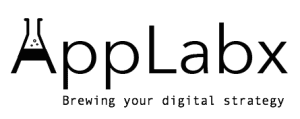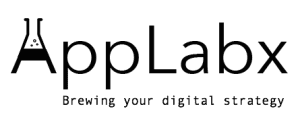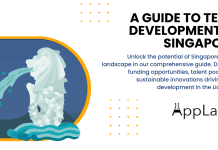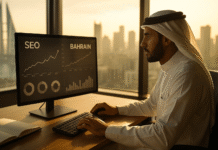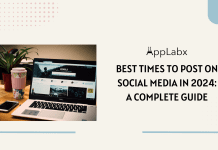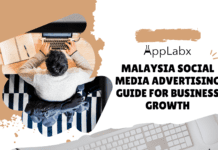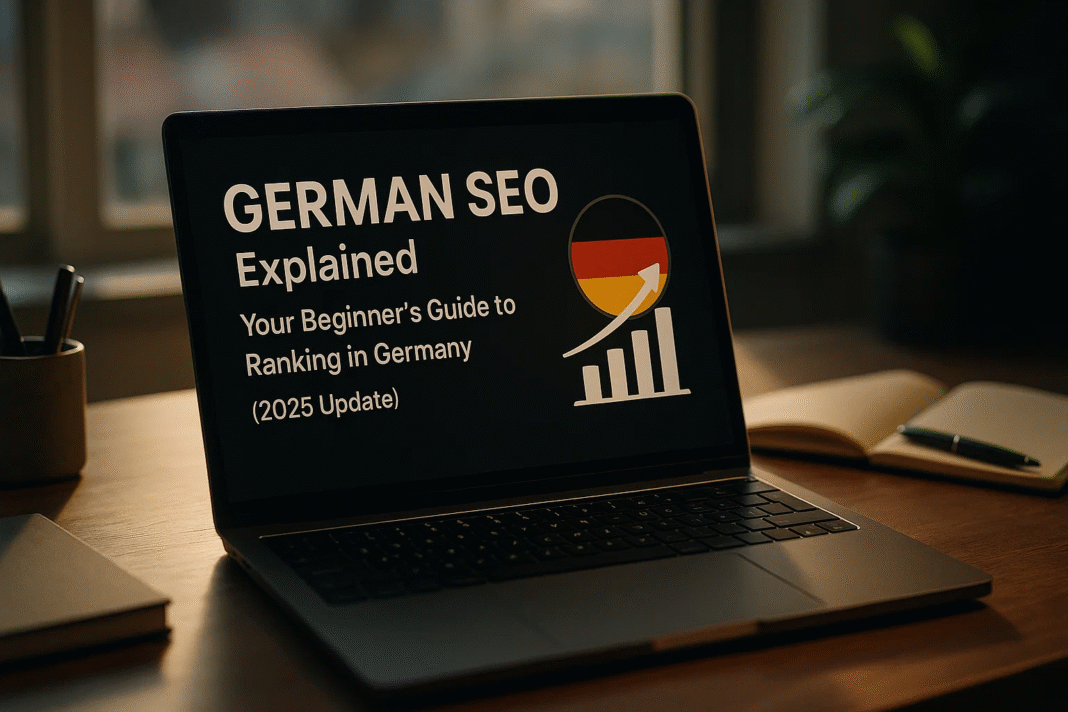Key Takeaways
- German SEO in 2025 requires native keyword research, localisation, and compliance with GDPR standards.
- Success depends on region-specific content, mobile-first design, and culturally aligned on-page optimisation.
- Leveraging local directories, structured data, and technical audits boosts visibility on Google.de.
In the ever-evolving landscape of digital marketing, mastering search engine optimisation (SEO) has become non-negotiable for businesses aiming to thrive online. Nowhere is this more evident than in Germany—Europe’s largest economy and one of the world’s most digitally mature markets. As of 2025, the German digital ecosystem has reached unprecedented levels of complexity and competitiveness, making it essential for businesses, marketers, and entrepreneurs to understand and implement SEO strategies tailored specifically to this market.

This guide, “German SEO Explained: Your Beginner’s Guide to Ranking in Germany (2025 Update),” is designed to help you build a strong foundation in SEO with a clear focus on the unique attributes of the German digital environment. Whether you’re an international brand expanding into Germany, a local startup, or a freelance marketer managing clients in the DACH region, this guide provides the insights needed to navigate the intricacies of German search engines, algorithms, and consumer behaviors.
Why SEO in Germany Requires a Specialised Approach
Germany is not just another European market. With a population exceeding 83 million, high internet penetration, and a digitally literate audience, the competition for search visibility is fierce. Yet, the key to SEO success in Germany lies in understanding its local nuances—linguistic precision, regional diversity, strict data protection regulations, and high expectations for content quality.
The dominance of Google.de remains strong, but Germany’s SEO environment diverges significantly from other English-speaking markets. German users value accuracy, professionalism, and culturally adapted content. Strategies that may work well in the US or UK often require reconfiguration to resonate with German audiences. Simple translation won’t suffice; true localisation and an understanding of user intent in German are critical.
Key Developments in German SEO in 2025
The SEO landscape in Germany has undergone significant transformation in recent years. Several key developments are shaping the way websites are optimised and ranked:
- Mobile-first indexing and Core Web Vitals are now foundational to achieving visibility, especially as Germany witnesses increasing mobile usage across all demographics.
- AI-driven search features, such as Google’s Search Generative Experience (SGE), are becoming more integrated into how users interact with search engines in German.
- Voice search adoption is on the rise, demanding a more conversational and semantic approach to keyword targeting in the German language.
- Local SEO has become even more critical, with Google Business Profile and local citations playing a larger role in connecting businesses to customers in specific cities or regions.
In addition, compliance with GDPR and user experience regulations is stricter than ever. Germany’s meticulous legal framework affects everything from cookie banners to user data handling, meaning your SEO strategy must also align with legal and ethical expectations.
What This Guide Covers
This comprehensive beginner’s guide will walk you through every essential aspect of German SEO in 2025—from understanding how Germans use search engines to crafting high-quality content that ranks well on Google.de. Here’s what you can expect:
- A breakdown of the current search engine market share in Germany and how user behavior influences SEO strategy
- Step-by-step guidance on keyword research, content creation, and on-page SEO tailored to German audiences
- Insights into local SEO best practices for regional visibility in major cities like Berlin, Munich, and Hamburg
- An overview of technical SEO considerations for German domains, including site speed, indexing, and structured data
- A detailed look at link building, GDPR compliance, and common SEO mistakes to avoid in the German context
Who Should Read This?
This guide is perfect for anyone looking to enter or improve their performance in the German digital market, including:
- International companies expanding their SEO reach into Germany
- German entrepreneurs and SMEs aiming to increase online visibility
- Marketing professionals and agencies working with clients in the DACH region
- Content creators and bloggers who want to reach a German-speaking audience
By the end of this guide, you will have a solid, actionable understanding of how to optimise your website for search engines in Germany. More importantly, you’ll be equipped with the local knowledge necessary to compete effectively in one of Europe’s most competitive online markets.
Let’s dive into the fundamentals of German SEO and unlock your path to higher visibility, increased traffic, and long-term digital growth in Germany.
But, before we venture further, we like to share who we are and what we do.
About AppLabx
From developing a solid marketing plan to creating compelling content, optimizing for search engines, leveraging social media, and utilizing paid advertising, AppLabx offers a comprehensive suite of digital marketing services designed to drive growth and profitability for your business.
At AppLabx, we understand that no two businesses are alike. That’s why we take a personalized approach to every project, working closely with our clients to understand their unique needs and goals, and developing customized strategies to help them achieve success.
If you need a digital consultation, then send in an inquiry here.
German SEO Explained: Your Beginner’s Guide to Ranking in Germany (2025 Update)
- Understanding the German Search Landscape in 2025
- Key Ranking Factors for German SEO in 2025
- Keyword Research for the German Market in 2025
- Content Strategy for German Audiences in 2025
- On-Page SEO Essentials for Germany in 2025
- Link Building in the German SEO Ecosystem in 2025
- Local SEO in Germany in 2025
- Technical SEO for German Websites in 2025
- Common Mistakes in German SEO (And How to Avoid Them) in 2025
- Tools and Resources for German SEO in 2025
1. Understanding the German Search Landscape in 2025
To succeed in German SEO in 2025, it is critical to understand the unique characteristics of the search landscape in Germany. Unlike generic global SEO strategies, ranking well in Germany requires localisation, insight into regional user behavior, and an awareness of platform preferences and technological adoption.
Search Engine Market Share in Germany (2025)
While Google.de continues to dominate, other search engines maintain niche relevance. Here’s how the market is distributed:
| Search Engine | Market Share (%) | Key Notes |
|---|---|---|
| Google.de | 91.3% | Dominates both desktop and mobile; highly integrated into German browsing |
| Bing | 4.2% | Mostly used by corporate users and default on Microsoft products |
| DuckDuckGo | 1.7% | Gaining traction among privacy-conscious users |
| Ecosia | 1.5% | A Berlin-based eco-friendly search engine; popular among younger users |
| Yahoo | 0.6% | Legacy users; limited SEO opportunity |
| Others (Web.de, GMX) | 0.7% | Niche portals often bundled with email services |
Key Insight:
- Optimising for Google.de should remain the primary focus.
- Consider technical SEO compatibility with Bing and privacy-focused platforms like DuckDuckGo for added reach.
Search Behaviour of German Users
German users approach search differently compared to English-speaking audiences, with a strong preference for clarity, precision, and trustworthiness.
Notable Traits:
- Formal Language Usage:
- Preference for “Sie” over “du” in professional contexts.
- Keyword research must consider both formal and casual variations.
- Keyword Specificity:
- Germans often use more descriptive search terms.
- Example: Instead of “coffee shop Berlin,” they search for “beste Kaffeerösterei in Berlin Mitte”.
- Cautious Click Behavior:
- Higher tendency to skip ads and prefer organic listings.
- High click-through rates (CTR) for featured snippets and trusted domains.
- Mobile Search Habits:
- Common mobile queries include directions, opening hours, and local reviews.
- Example: “Restaurant in der Nähe geöffnet jetzt” (restaurant near me open now).
Desktop vs Mobile Search Trends
As of 2025, mobile devices continue to dominate in Germany, but desktop still maintains relevance for B2B and professional search intent.
| Device Type | Usage Share (%) | Common Use Cases |
|---|---|---|
| Mobile | 63% | Local search, consumer shopping, on-the-go queries |
| Desktop | 35% | Research, B2B, work-related search |
| Tablet | 2% | Casual browsing, often used by older demographics |
SEO Implications:
- Mobile-first indexing is non-negotiable.
- Responsive design, fast load times, and thumb-friendly navigation are critical.
Voice Search and Natural Language Queries
Voice search adoption in Germany continues to grow, particularly among younger and tech-savvy users.
Trends and Examples:
- Use of long-tail conversational queries is on the rise.
- Example: “Welches ist das beste italienische Restaurant in meiner Nähe?”
- Integration with smart speakers like Amazon Echo and Google Nest is increasing voice-first browsing.
Action Points:
- Optimise content for question-based keywords.
- Include FAQs and schema markup for voice-featured snippets.
AI, SERP Features, and Personalised Results
German users are interacting more with dynamic SERP features driven by AI.
Common SERP Elements:
- Featured Snippets
- Knowledge Panels (especially for companies, people, and cities)
- People Also Ask boxes (translated as “Andere Fragen” in Google.de)
- Local Packs and Maps
Example:
- A search for “Webdesign Agentur München” might show:
- A 3-pack of local agencies
- Reviews pulled from Google Business Profiles
- Additional questions like “Was kostet Webdesign in München?”
Matrix: SERP Element vs User Intent
| User Intent | SERP Features | Optimisation Strategy |
|---|---|---|
| Informational | Featured Snippet, PAA | Clear headers, structured data, concise answers |
| Navigational | Sitelinks, Knowledge Panel | Branded SEO, schema, internal linking |
| Transactional | Local Pack, Reviews, Ads | Google Business Profile, positive reviews, CTAs |
| Research/Comparison | Listicles, PAA, Snippets | Comparison tables, bullet content, long-form articles |
Regional and Localised Search Variations
Germany’s SEO landscape is highly regionalised. User preferences, dialects, and search habits vary between states and cities.
Examples of Variations:
- In Berlin, searches may favour tech startups and modern services.
- In Bavaria, local terms like “Getränkemarkt” (beverage store) are more common than general terms like “Supermarkt”.
Best Practices:
- Use geo-targeted landing pages with city-specific keywords.
- Implement hreflang tags correctly if offering content in multiple regional dialects or languages.
Conclusion: Adapting to the German Search Environment
To rank successfully in Germany in 2025, businesses must:
- Prioritise Google.de but remain aware of emerging alternatives like Ecosia.
- Focus on keyword localisation, cultural relevancy, and compliance with local expectations.
- Align content with regional language use, user search intent, and device behavior.
Understanding the search landscape is the foundation of every effective German SEO strategy. The next sections will build on this knowledge by exploring keyword research, content creation, and technical optimisation specifically tailored to the German market.
2. Key Ranking Factors for German SEO in 2025
Achieving high rankings on German search engines in 2025—especially Google.de—requires a tailored SEO strategy that goes beyond global best practices. Success hinges on understanding a mix of linguistic, technical, and behavioral nuances specific to German users. This section outlines the most critical ranking factors that influence search visibility in Germany today.
High-Quality, Localised Content in German
Content remains king in 2025—but not just any content. For German SEO, content must be linguistically accurate, culturally appropriate, and tailored to regional search intent.
Best Practices:
- Write content natively in German (avoid direct translations from English).
- Use regional vocabulary and idioms relevant to specific German states or cities.
- Example: “Brötchen” in North Germany vs. “Semmel” in Bavaria.
- Prioritise depth, factual accuracy, and authority in content creation.
- Ensure content uses correct grammar, spelling (ß vs ss), and formal tone where needed.
Content Quality Checklist (German Context):
| Factor | Requirement | Impact |
|---|---|---|
| Native German language | Fluent, idiomatic, culturally aware | High dwell time, low bounce |
| Regional relevance | City/district-specific content | Better local visibility |
| Informational depth | >1000 words per pillar page | Higher topical authority |
| Originality | No AI-only or duplicate content | Prevents penalties |
Technical SEO Optimisation for German Websites
German users expect fast, reliable, and secure websites. Search engines do too. Technical SEO ensures your site architecture and infrastructure meet these standards.
Technical Factors to Prioritise:
- Mobile-first indexing
- All sites must be fully responsive. Google now uses mobile versions for indexing by default.
- Core Web Vitals
- Largest Contentful Paint (LCP): <2.5s
- First Input Delay (FID): <100ms
- Cumulative Layout Shift (CLS): <0.1
- HTTPS security is mandatory, especially with GDPR considerations.
- Fast loading speeds are essential, particularly on mobile networks like 5G.
Core Web Vitals Performance:
| Metric | Benchmark | Priority | Optimisation Tactics |
|---|---|---|---|
| LCP | <2.5 seconds | Critical | Compress images, lazy load, CDN usage |
| FID | <100 ms | High | Reduce JS, minimise third-party scripts |
| CLS | <0.1 | High | Set fixed sizes on images and elements |
On-Page SEO and German-Specific Optimisations
On-page SEO in Germany requires careful attention to language, keyword intent, and compliance with localisation norms.
Key On-Page Elements:
- Title tags and meta descriptions in German
- Use keywords naturally (e.g., “beste SEO Agentur in Frankfurt”).
- H1-H4 structure must be clear, scannable, and semantic.
- Alt text and image filenames should also be in German, describing the content precisely.
- Internal linking should be logical and reinforce topic clusters.
SEO Metadata Example (Local Business Page):
| Element | Optimised Example (German) |
|---|---|
| Title Tag | Webdesign Agentur Berlin – Professionelle Webseiten 2025 |
| Meta Description | Unsere Webdesign Agentur in Berlin erstellt moderne, schnelle und mobilfreundliche Webseiten. Jetzt kostenlos beraten lassen. |
| H1 Tag | Professionelle Webdesign Lösungen in Berlin |
| Alt Text (image) | Responsive Webdesign Beispiel für Berliner Unternehmen |
User Experience (UX) and Behavioral Signals
Search engines increasingly rely on user interaction metrics to determine relevance and ranking potential.
Important UX Metrics:
- Click-through rate (CTR) on German SERPs
- Dwell time and session duration
- Bounce rate and return visits
Enhancement Strategies:
- Use clear CTAs like “Jetzt kaufen” or “Kostenlos testen”
- Create engaging visuals and interactive elements
- Optimise navigation and ensure language clarity across UI
Mobile Optimisation and Local Usability
Germany’s mobile usage has skyrocketed, especially for local queries and e-commerce.
Mobile SEO Focus Areas:
- Responsive layouts and mobile-friendly menus
- Thumb-friendly CTAs
- Fast-loading pages on mobile networks
- Ensure usability on devices commonly used in Germany (Android dominance)
Top Mobile Use Cases in Germany:
| Search Intent | Example Query | Action Triggered |
|---|---|---|
| Local store locator | “Schuhgeschäft in meiner Nähe geöffnet jetzt” | Google Maps navigation |
| Restaurant reservations | “Tisch reservieren Sushi Berlin” | Call-to-action via Google Business |
| Product reviews | “Testbericht E-Bike 2025 Stiftung Warentest” | Visit to review site |
Structured Data and Rich Results in German SERPs
Schema markup helps Google understand your content—and is essential for rich snippets.
Types of Schema to Use:
- LocalBusiness
- Product
- Review
- FAQ
- BreadcrumbList
- Event (especially for city-level campaigns)
Example: German FAQPage Schema
{
"@context": "https://schema.org",
"@type": "FAQPage",
"mainEntity": [{
"@type": "Question",
"name": "Was ist SEO und warum ist es wichtig?",
"acceptedAnswer": {
"@type": "Answer",
"text": "SEO steht für Suchmaschinenoptimierung und hilft Websites, in den organischen Suchergebnissen besser gefunden zu werden."
}
}]
}
Trust, Authority & E-E-A-T for German Audiences
Trust is a cornerstone of German consumer behavior, and search engines reflect this in their ranking algorithms.
Build Authority by:
- Displaying credentials, certifications, awards (e.g., TÜV, Trusted Shops)
- Using real author bylines and bios on blog content
- Linking to reputable German domains like .gov.de, .org.de, or major news portals
Trust Signals Matrix:
| Trust Element | German Expectation | SEO Benefit |
|---|---|---|
| Author transparency | Full name, credentials, photo | Boosts E-E-A-T and CTR |
| Company reviews | >4 stars on Google and Trustpilot.de | Improves local pack visibility |
| Legal pages | Impressum, Datenschutzerklärung, AGB | Required for GDPR compliance |
Local SEO Signals for Google.de
For businesses targeting local German audiences, local SEO signals are vital.
Must-Have Local Ranking Factors:
- Optimised Google Business Profile (in German)
- Local citations in German directories (e.g., Das Örtliche, Gelbeseiten.de)
- NAP consistency (Name, Address, Phone Number)
- Geo-tagged images and local keywords
Example: Local SEO Listing in Munich
- Business Name: Bäckerei Müller
- Address: Sonnenstraße 12, 80331 München
- Keywords: “Frische Brötchen München Zentrum”, “Bäckerei geöffnet Sonntag”
Conclusion: Ranking Smarter in the German SEO Ecosystem
To win in Germany’s 2025 search landscape, SEO practitioners must:
- Combine technically sound foundations with localised, culturally aware content
- Optimise for user experience and mobile devices
- Build trust and transparency into every element of the website
- Make use of structured data and SERP-enhancing strategies
These ranking factors are not static—they evolve in step with search engine updates and shifting user expectations. Consistent monitoring, adaptation, and testing are essential to maintaining and improving your position in German SERPs.
3. Keyword Research for the German Market in 2025
In 2025, successful SEO campaigns targeting Germany require much more than translating English keywords into German. The process involves deep localisation, understanding regional search behavior, and using tools that support German-language insights. This section explores advanced, SEO-optimised techniques for conducting keyword research tailored to Germany’s diverse and evolving digital environment.
Why German Keyword Research Requires a Unique Approach
Keyword behaviour in Germany is different due to linguistic, cultural, and regional factors.
Key Differences from English Markets:
- Compound nouns are common (e.g., “Autoversicherung” = car insurance).
- Regional synonyms exist for many common terms.
- Example: “Brötchen” (North) vs. “Semmel” (South) for bread rolls.
- Search formality affects user intent.
- “günstige Hotels” (cheap hotels, informal) vs. “preiswerte Unterkünfte” (affordable accommodations, formal).
- Word order can change intent and competition.
- “Webdesign Agentur Berlin” vs. “Berlin Webdesign Agentur”.
Top Tools for German Keyword Research (2025)
Accurate keyword planning starts with the right tools—preferably those with German data indexing, local SERP previews, and linguistic adaptability.
| Tool | Use Case | Strength in German SEO |
|---|---|---|
| Sistrix | SERP tracking, keyword discovery | Deep German database and visibility index |
| Ubersuggest | Keyword ideas, domain analysis | Good for long-tail German queries |
| SEMrush | Competitor research, topic clusters | German keyword database with local intent filters |
| Google Keyword Planner | Ad-based search volume estimates | Free, localised keyword data for Germany |
| AnswerThePublic | Question-based keyword research | Excellent for German conversational queries |
| ahrefs | Competitor keywords, backlink-related terms | Supports .de domains and German phrases |
Types of Keywords to Target in Germany
Diverse keyword types are necessary for capturing traffic across the buyer’s journey.
Breakdown of German Keyword Types:
| Type | Example (German) | Intent | Usage |
|---|---|---|---|
| Short-tail | “SEO” | Informational/General | Topic-level pages, category descriptions |
| Long-tail | “beste SEO Agentur für kleine Unternehmen 2025” | Transactional/Specific | Blog posts, service pages |
| Localised | “Webdesigner Hamburg Altona” | Navigational/Local | Google Business and landing pages |
| Question-based | “Was kostet SEO in Deutschland?” | Informational | FAQ and blog sections |
| Commercial | “vergleich Autoversicherung 2025” | Transactional | Review and comparison content |
| Branded | “Sistrix Alternativen” | Navigational | Competitor analysis, PPC blocking |
Finding and Validating German Keywords
Use a layered research strategy to ensure relevance, search volume, and intent match.
Step-by-Step Approach:
- Start with seed terms in German
- Begin with core industry terms like “Rechtsanwalt Berlin” (lawyer Berlin).
- Use autosuggest from Google.de
- Observe real-time suggestions and PAA boxes.
- Validate with tools
- Check monthly search volume and CPC in German markets.
- Identify intent based on SERP layout
- Informational = blog results, videos
- Transactional = product pages, ads
- Local = maps, review snippets
Example Keyword Validation Table:
| Keyword | Search Volume (DE) | CPC (€) | Intent Type | Suggested Page Type |
|---|---|---|---|---|
| “SEO Agentur Berlin” | 2,900 | 4.20 | Transactional | Local service page |
| “Wie funktioniert SEO?” | 1,200 | 1.10 | Informational | Blog article |
| “beste SEO Tools 2025” | 880 | 3.50 | Commercial | Review or comparison post |
| “Webdesign München Preise” | 720 | 2.70 | Transactional | Pricing or quote landing page |
Search Intent in German Keyword Strategy
Understanding Search Intent is vital for matching keywords with user expectations.
German Search Intent Framework:
| Intent Type | Typical Keywords | Best Page Match |
|---|---|---|
| Informational | “wie macht man ein Backup” | Blog post, guide, explainer video |
| Navigational | “Zalando Kundenservice” | Homepage or internal brand page |
| Transactional | “E-Bike kaufen Berlin” | Product, service, landing page |
| Commercial Research | “beste E-Mail Marketing Tools 2025 Vergleich” | Review/comparison pages |
| Local | “Zahnarzt Hamburg Altona Notdienst” | GBP profile, local SEO-optimised page |
Tip: German users often research heavily before making a transaction. Include comparison charts and trust signals in pages targeting commercial keywords.
Long-Tail and Semantic Keywords in German
Long-tail keywords are especially powerful in Germany due to the nature of the language.
Why They Work:
- German grammar allows very specific compound terms.
- Lower competition and higher conversion rates.
- Align better with voice search and conversational AI tools.
Examples of Effective Long-Tail Keywords:
- “günstige Ferienwohnungen am Bodensee mit Hund erlaubt”
- “was kostet eine Zahnreinigung in Berlin 2025”
- “beste Steuerberater für Selbständige in Köln”
Optimisation Strategies:
- Create FAQ sections addressing long-tail questions.
- Use question-based H2s/H3s in blog posts.
- Optimise voice search by including full-sentence answers.
Local Keyword Targeting by Region or City
Germany has 16 federal states and countless local dialects and regional search patterns.
Top Cities to Geo-Target:
| City | Popular Local Keywords (2025) |
|---|---|
| Berlin | “SEO Agentur Berlin Mitte”, “Startup Marketing Berlin 2025” |
| Hamburg | “Webdesign Hamburg Altona”, “Marketing Agentur Hamburg Hafen” |
| Munich (München) | “Online Marketing München Schwabing”, “SEO Beratung Bayern” |
| Frankfurt | “Digitale Agentur Frankfurt Main”, “SEO Freelancer Hessen” |
| Cologne (Köln) | “Marketing Agentur Köln Innenstadt”, “Texter gesucht NRW” |
Geo-Targeting Tips:
- Use dedicated landing pages for each city or state.
- Incorporate local business schema.
- Embed Google Maps and local reviews/testimonials.
Keyword Mapping and Content Planning
Once keywords are identified, map them strategically across your website.
Keyword Mapping Matrix:
| Page Type | Primary Keyword | Secondary Keywords | Purpose |
|---|---|---|---|
| Homepage | “Digitale Marketing Agentur Deutschland” | “Online Marketing Services Germany”, “SEO & PPC” | Brand positioning |
| Service Page (Local) | “SEO Agentur Hamburg” | “SEO Beratung Hamburg”, “Google Ranking Hamburg” | Local lead generation |
| Blog Article | “SEO Trends Deutschland 2025” | “Google Updates DE 2025”, “Neues in der SEO Branche” | Traffic and topical authority |
| FAQ Section | “Was ist SEO?” | “Wie funktioniert SEO?”, “Was kostet SEO in 2025?” | Informational coverage |
Conclusion: Building a Keyword Strategy that Works in Germany
Keyword research in Germany in 2025 requires a combination of linguistic precision, tool-based validation, and intent-matched content planning. Avoid direct translations and instead focus on:
- Native keyword discovery
- Long-tail and regional search patterns
- Intent-driven targeting
- Ongoing analysis and refinement
A thoughtful keyword strategy built on German search behavior will set the foundation for higher rankings, stronger engagement, and increased conversions across the DACH region.
4. Content Strategy for German Audiences in 2025
In 2025, crafting content for German audiences goes far beyond translating English copy into German. Success requires native-level fluency, cultural alignment, and strategic SEO integration that respects Germany’s unique digital behavior, formality norms, and high expectations for quality. German users are critical thinkers, value accuracy, and demand depth in content—traits that shape how content should be structured, written, and optimised.
This section explores how to develop a content strategy specifically tailored for Germany’s digital market in 2025.
Understand German Reader Expectations and Behavior
German consumers are discerning and prefer content that is logical, structured, and evidence-based.
Audience Preferences:
- Clarity and structure: Use of headings, subheadings, bullet points, and tables
- Formal tone: Especially in B2B, finance, healthcare, and legal sectors
- Proof and credibility: Germans trust certifications, sources, data, and reviews
- Concise intros, in-depth bodies: They want quick relevance, then detailed answers
- Trust signals: TÜV badges, customer testimonials, and local examples
Example: Tone Differentiation
| Audience | Tone Style | Example Phrase |
|---|---|---|
| B2C (Youth/Fashion) | Casual, friendly | “Hol dir jetzt deinen Style für den Sommer!” |
| B2B (Finance/Legal) | Formal, authoritative | “Erfahren Sie mehr über unsere Compliance-Lösungen” |
| Public Sector | Neutral, institutional | “Bitte beachten Sie die geltenden Richtlinien” |
Developing Localised, Native Content (Not Just Translated)
Native content creation is key to winning search visibility and trust in Germany.
Best Practices:
- Hire native-speaking writers or German SEO copywriters
- Consider regional dialects or preferences
- “Rechtsanwalt” vs “Anwalt” depending on tone/formality
- Avoid machine translation
- Write in D-A-CH standard German (Germany-Austria-Switzerland) if targeting all German-speaking countries
Content Adaptation Matrix:
| Global Content Element | German Localisation Strategy | Reason |
|---|---|---|
| Case Studies | Use German companies or EU-centric case examples | Builds relevance and trust |
| Testimonials | Feature German names and local cities | Enhances local engagement |
| Visuals | Replace US-centric images with German or EU visuals | Cultural resonance |
| Statistics | Cite German or EU sources (e.g., Statista.de, Destatis) | Establishes authority and relevance |
Content Formats That Perform Best in Germany
Different content types serve different stages of the user journey in Germany’s market.
High-Performing Content Types:
- How-to guides and step-by-step instructions
- Vergleichstabellen (comparison tables) and product reviews
- Whitepapers and downloadable PDFs for B2B lead gen
- FAQs (especially long-form and detailed)
- Local landing pages optimised for cities or regions
Content-Type Performance Chart (2025):
| Content Type | Conversion Impact | SEO Visibility | Best Use Case |
|---|---|---|---|
| Blog Articles | Medium | High | Educational, informational queries |
| Case Studies | High | Medium | B2B trust-building, bottom-funnel content |
| Comparison Pages | High | High | Commercial and transactional keywords |
| Local Pages | Very High | Very High | Regional targeting, Google Maps inclusion |
| Video (embedded) | Medium | Medium | Visual storytelling, product explanations |
Topic Clustering and Topical Authority in German
German SEO in 2025 favors websites that demonstrate topical expertise rather than one-off keyword targeting.
Topic Cluster Strategy:
- Pillar Page: Main topic with high-volume keyword
- Example: “Suchmaschinenoptimierung in Deutschland”
- Cluster Pages: Supporting long-tail articles
- “SEO für lokale Unternehmen in Berlin”
- “Mobile-First Indexierung verstehen”
- “SEO Checkliste 2025”
Benefits of Topic Clusters:
- Increases internal linking opportunities
- Enhances dwell time and reduces bounce rate
- Strengthens site authority on specific subjects
Visual Example: Topic Cluster Model
SEO in Deutschland
(Pillar)
|
-----------------------------------------------------
| | |
SEO für KMU Technisches SEO Content Marketing DE
(Cluster) (Cluster) (Cluster)
Content Calendar for German SEO Campaigns (2025 Edition)
Planning content around seasonality, regional events, and search trends enhances visibility.
Content Calendar Suggestions:
| Month | Top Seasonal Topics (Germany) | Industry |
|---|---|---|
| January | “Steuertipps zum Jahresanfang” | Finance, Tax |
| March | “Frühjahrsputz Checkliste” | Home, Lifestyle |
| May | “SEO Trends Deutschland zur Halbzeit 2025” | Digital Marketing |
| July | “Sommerangebote 2025 – Die besten Online-Shops” | E-commerce, Retail |
| September | “Back to School – Tipps für Eltern in Deutschland” | Education, Family |
| November | “Black Friday Angebote Deutschland 2025” | E-commerce, Tech |
| December | “Weihnachtsgeschenke Ideen für Männer/Frauen 2025” | B2C, Lifestyle, Shopping |
Internal Linking and Content Hierarchy
German users expect structured navigation and topic clarity.
Hierarchy Tips:
- Use descriptive anchor text in German
- Avoid generic terms like “hier klicken”; use “mehr über unsere SEO-Dienstleistungen”
- Create breadcrumb navigation for deep articles
- Use H1–H4 headings correctly and include keywords in H2s and H3s
Example: Blog Article Structure
H1: SEO Tipps für kleine Unternehmen in Deutschland
H2: Warum SEO 2025 wichtig ist
H3: Neue Google-Algorithmen verstehen
H2: Keyword-Recherche für lokale Sichtbarkeit
H3: Tools für Deutschland
H2: Fazit: So gelingt der Einstieg
Incorporating German Cultural References and Trends
To truly connect with German audiences, reflect current events, values, and references.
Integration Ideas:
- Mention well-known German publications (e.g., “Laut einem Bericht der Süddeutschen Zeitung…”)
- Reference national events (e.g., Bundestagswahl, Fußball-EM)
- Align with German values such as Datenschutz (data privacy), Umweltbewusstsein (eco-consciousness), and Qualität (quality)
E-E-A-T Principles and German Content Standards
Expertise, Experience, Authoritativeness, and Trustworthiness (E-E-A-T) play a central role in SEO rankings—especially in Germany where users are cautious.
E-E-A-T Application in German Content:
- Use expert author bios with credentials
- Include citations from .gov.de, .org.de, or respected German sources
- Display real user reviews and client case studies
- Clearly show Impressum and Datenschutzerklärung
Content Performance Tracking for Germany
Measure what matters by focusing on KPIs that reflect local user engagement.
Key Content Metrics to Monitor:
| Metric | Purpose | Tool Suggestion |
|---|---|---|
| Organic Traffic (DE) | Measure local reach | Google Search Console |
| Bounce Rate | Identify poor content matches | Matomo or GA4 |
| Avg. Session Duration | Evaluate content engagement | GA4 |
| Keyword Rankings (DE) | Monitor visibility for German queries | Sistrix, SEMrush, Ahrefs |
| Backlink Growth (DE) | Track trust-building from German domains | ahrefs, LinkResearchTools.de |
Conclusion: The Pillars of a Successful German Content Strategy
To rank well in German search results in 2025, your content strategy must:
- Be natively written in German
- Address local user intent, behavior, and tone preferences
- Focus on structured, high-quality content with a topical approach
- Integrate internal linking, cultural context, and E-E-A-T principles
- Be planned seasonally and regionally for relevance and reach
A thoughtful, native-first content strategy will not only improve your SEO visibility in Germany but also build brand authority, audience trust, and long-term conversion potential.
5. On-Page SEO Essentials for Germany in 2025
In the German digital ecosystem of 2025, on-page SEO is a foundational pillar for achieving high search visibility on platforms like Google.de. With rising competition, AI-driven SERPs, and evolving user expectations, businesses must optimise every page element to align with Germany’s linguistic, cultural, and technical standards. This section explores the critical on-page SEO strategies tailored for the German market, ensuring content ranks effectively and delivers meaningful engagement.
Language and Localisation Best Practices
Precision in language and localisation is non-negotiable when targeting German users.
Key Guidelines:
- Use native German content — no machine translation or awkward phrasing.
- Match search intent by adapting phrasing for formality:
- “Günstiger Stromtarif finden” (informal)
- “Preiswerter Stromtarif vergleichen” (formal)
- Incorporate regional language for local SEO:
- “Bäckerei in München Schwabing” vs “Bäckerei Bayern”
- Use region-specific nouns like “Semmel” (South Germany) or “Brötchen” (North)
Language Optimisation Table:
| Content Type | Formal German | Informal Equivalent |
|---|---|---|
| Legal & Finance | “Erfahren Sie mehr über unsere Leistungen” | “Lerne unsere Services kennen” |
| Retail & E-commerce | “Jetzt Produktdetails ansehen” | “Check das Produkt jetzt” |
| Local Services | “SEO-Agentur in Frankfurt am Main” | “SEO Frankfurt” |
Title Tags & Meta Descriptions (Optimised for Google.de)
Title tags and meta descriptions play a vital role in CTR and keyword relevance on German SERPs.
Best Practices:
- Keep title tags under 60 characters and meta descriptions under 155.
- Include primary keyword at the beginning.
- Reflect user query formats and localised phrases.
- Avoid clickbait; Germans prefer accuracy over hype.
Example Optimised Metadata (Real Estate Berlin):
| Element | Optimised Example (German) |
|---|---|
| Title Tag | “Immobilienmakler Berlin – Wohnungen & Häuser kaufen 2025” |
| Meta Description | “Finden Sie mit unserer Berliner Immobilienagentur Ihr neues Zuhause. Jetzt Beratung vereinbaren – Transparent & zuverlässig.” |
Header Tags (H1–H4) and Content Structure
A logical header structure improves readability and search engine comprehension.
Guidelines:
- Use one H1 per page, reflecting the main keyword.
- H2–H4 should break down subtopics and include secondary keywords.
- Maintain a hierarchical structure for topical clarity.
Example Header Structure (Digital Marketing Page):
H1: Digitale Marketing Strategien für den deutschen Markt 2025
H2: Warum digitales Marketing in Deutschland wächst
H3: Nutzerverhalten 2025 verstehen
H2: Effektive Kanäle für Unternehmen in Deutschland
H3: SEO
H3: E-Mail Marketing
H3: Paid Media (Google Ads, Social)
URL Structure and Slug Optimisation
URLs should be short, descriptive, and written in German for clarity and keyword alignment.
Best Practices:
- Use hyphens instead of underscores.
- Include primary keyword and location when relevant.
- Avoid English words unless branded.
Example URL Structure:
| Page Type | Optimised German URL |
|---|---|
| Local SEO Agency | /seo-agentur-hamburg |
| Product Page | /elektrofahrrad-berlin-2025 |
| Blog Article | /google-ranking-faktoren-deutschland-2025 |
Image Optimisation and Alt Attributes in German
Images contribute to user engagement and can drive organic traffic via image search.
On-Page Image SEO Checklist:
- Compress images for fast load speeds.
- Use descriptive German filenames (e.g., seo-checkliste-2025.jpg).
- Include alt text that describes the image in German, using keywords naturally.
Example Alt Text Table:
| Image Purpose | Alt Text (German) |
|---|---|
| Local SEO Graphic | “Local SEO Strategie für München – Google Maps Optimierung” |
| Product Image | “Schwarzes E-Bike 2025 mit Aluminiumrahmen” |
| Team Photo | “Team der SEO-Agentur in Frankfurt am Main” |
Internal Linking and Content Flow
Strategic internal links enhance topical depth, crawlability, and user retention.
Internal Linking Best Practices:
- Link to related articles and service pages using keyword-rich anchor text.
- Use contextual placement within body paragraphs.
- Keep a consistent internal link structure for content clusters.
Example Anchor Text Map:
| From Page | To Page | Anchor Text (German) |
|---|---|---|
| SEO Trends 2025 | SEO Checkliste Deutschland | “aktuelle SEO Checkliste für 2025” |
| Webdesign Leistungen München | SEO München | “ergänzende SEO-Dienstleistungen in München” |
| Content Marketing Grundlagen | Content Strategie D-A-CH Raum | “Content Strategie für den deutschsprachigen Markt” |
Keyword Placement and Density
Smart keyword usage signals relevance while preserving natural flow.
Placement Priorities:
- Title tag
- First 100 words of the page
- H1 and H2 headings
- Image alt text
- URL and meta description
Recommended Keyword Density (German Pages):
- Primary Keyword: ~1.5–2% per page
- Secondary Keywords: 3–5 times per 1000 words
- Avoid keyword stuffing and unnatural repetition
Schema Markup and Structured Data for German Pages
Enhancing search visibility through schema is essential for modern SEO.
Top Schema Types for Germany (2025):
LocalBusiness: For regional visibilityFAQPage: For voice and snippet resultsProduct: For e-commerce platformsArticle: For blog content and news articles
Example: FAQPage Schema in German
{
"@context": "https://schema.org",
"@type": "FAQPage",
"mainEntity": [
{
"@type": "Question",
"name": "Wie funktioniert Local SEO in Deutschland?",
"acceptedAnswer": {
"@type": "Answer",
"text": "Local SEO optimiert Ihre Website und Ihr Google Business Profil, um in lokalen Suchergebnissen besser sichtbar zu sein."
}
}
]
}
Page Load Speed and Core Web Vitals for German Users
Performance is a ranking signal and a key UX factor, particularly on mobile networks in Germany.
Core Web Vitals Benchmarks (2025):
| Metric | Threshold | Optimisation Tactics |
|---|---|---|
| LCP (Largest Contentful Paint) | <2.5 seconds | Optimise images, preload fonts, reduce CSS |
| FID (First Input Delay) | <100 ms | Minimise JS, defer non-critical scripts |
| CLS (Cumulative Layout Shift) | <0.1 | Use size attributes for media, avoid pop-ups |
Tools to Monitor:
- Google PageSpeed Insights
- GTMetrix (DE server)
- Lighthouse
- Chrome UX Report (Germany segment)
Mobile-First Design for German SERPs
With 60%+ of German searches occurring on mobile, mobile UX impacts both SEO and conversion.
Key Mobile Optimisation Features:
- Responsive layout and adaptive breakpoints
- Large, clickable CTA buttons in German:
- “Jetzt Kontakt aufnehmen”
- “Gratis Beratung anfordern”
- Simplified navigation for mobile screens
- Prioritise page speed for 4G/5G networks
Legal Compliance and On-Page SEO
Germany has strict online regulations (GDPR, ePrivacy), which affect SEO indirectly.
On-Page Legal Elements to Include:
- Impressum (legal disclosure page) – legally required on all .de domains
- Datenschutzerklärung (privacy policy) – must explain tracking, cookies
- AGB (Allgemeine Geschäftsbedingungen) – if selling products/services
Compliance Impact Table:
| Legal Element | SEO Impact |
|---|---|
| Proper Impressum | Increases domain trust, avoids penalties |
| GDPR-consent banner | Reduces bounce rate when designed user-friendly |
| Transparent tracking | Builds trust, improves engagement and conversions |
Content-Length and Format Expectations in Germany
Germans prefer in-depth, well-structured pages with detailed, trustworthy information.
Recommended Content-Length Guidelines (2025):
| Page Type | Ideal Word Count | Notes |
|---|---|---|
| Blog Article | 1200–2000 words | Include statistics, internal links, citations |
| Local Landing Page | 800–1200 words | Include maps, location-based CTAs |
| Product/Service Page | 700–1000 words | Focus on benefits, FAQs, comparisons |
| Category Page (E-commerce) | 300–500 words | Use for SEO + navigation, avoid keyword stuffing |
Conclusion: Perfecting On-Page SEO for German Search in 2025
On-page SEO in Germany requires a meticulous, user-focused approach that combines:
- Native-level language use
- Technical accuracy and performance
- Clear structure and semantic markup
- Legal compliance and UX optimisation
- Cultural localisation across all elements
By applying these 2025-specific on-page SEO principles, brands can significantly improve their visibility, trust, and engagement across Google.de and other platforms serving German-speaking users.
6. Link Building in the German SEO Ecosystem in 2025
In 2025, link building continues to be a critical ranking factor in Germany’s SEO landscape. However, German SEO link strategies demand a more methodical, trust-centric, and localisation-driven approach than many other markets. Search engines like Google.de value backlinks that are authoritative, contextually relevant, and ethically acquired—especially from German-language domains.
This section explores the most effective, white-hat link building strategies designed for German audiences and algorithms in 2025.
Understanding the German Backlink Landscape
Before diving into strategies, it’s essential to understand what makes the German link ecosystem unique.
Characteristics of the German Link Landscape:
- High value placed on E-E-A-T (Experience, Expertise, Authoritativeness, Trustworthiness).
- Preference for .de domains or EU-based TLDs like .at or .ch.
- Strong editorial standards in top German publications (e.g., Handelsblatt, t3n, Golem.de).
- Low tolerance for manipulative link schemes—Google penalties are strict in the D-A-CH region.
- Emphasis on industry-specific and region-specific backlinks.
Top German TLDs and Their Trustworthiness:
| TLD | Country | SEO Trust Score (2025) | Usage Relevance |
|---|---|---|---|
| .de | Germany | 9.8/10 | Standard for German websites |
| .at | Austria | 9.2/10 | Relevant for Austria-focused sites |
| .ch | Switzerland | 9.1/10 | Swiss German audiences |
| .eu | European Union | 8.5/10 | Pan-European brands or policy sites |
| .com | Global | 7.9/10 | Acceptable if German-language based |
White-Hat Link Building Strategies for Germany in 2025
Ethical and effective link acquisition requires planning, outreach, and value-driven content.
1. Digital PR and Outreach
- Target online magazines, trade publications, and industry portals such as:
- t3n.de (Tech & Digital Business)
- gruenderszene.de (Startups)
- handelsblatt.com (Finance & Business)
- Publish data-driven studies, surveys, or whitepapers with unique German insights.
- Write press releases with a German PR distribution service (e.g., pressebox.de).
2. Content-Based Link Building
- Publish “Ultimate Guides” in German that attract organic links.
- Create industry-specific glossaries using German technical terms.
- Offer free tools, templates, or generators targeting German professionals.
3. Guest Blogging on German Platforms
- Submit guest posts to niche-relevant blogs with strict editorial standards.
- Use native German writers to ensure authenticity.
- Include natural in-content backlinks with non-promotional anchor text.
4. Link Reclamation
- Identify brand mentions without links using Ahrefs or SEMrush (DE filters).
- Reach out with a polite, localised email asking for backlink inclusion.
Best German Domains for Backlink Acquisition
High-authority domains in Germany offer significant ranking power when earned ethically.
| Domain | DA (Domain Authority) | Type | Link Opportunity |
|---|---|---|---|
| spiegel.de | 92 | National News Media | Data-driven stories or interviews |
| t3n.de | 76 | Tech/Digital Business | Thought leadership articles |
| gruenderszene.de | 71 | Startups & Entrepreneurship | Startup profiles, PR outreach |
| handelsblatt.com | 88 | Business & Finance | Economic commentary, opinion pieces |
| deutsche-startups.de | 64 | Startup Ecosystem | Guest columns, startup announcements |
| heise.de | 85 | Technology & IT | Research-based tech articles |
| akademie.de | 58 | Education & Tutorials | How-to guides, case studies |
Local Link Building and Regional SEO Relevance
For businesses targeting specific cities or Bundesländer (states), local backlinks are critical.
Tactics to Build Local Authority:
- List your business on Das Örtliche, Gelbeseiten.de, and meinestadt.de.
- Collaborate with local chambers of commerce or regional business networks.
- Sponsor local events, charities, or sports teams and request backlinks from their sites.
- Guest post or be interviewed on city-specific blogs or forums.
Example: Local Link Building in Berlin
| Source | Type | Example Page |
|---|---|---|
| berlin.de | Government/City Portal | Local business spotlight |
| startup-berlin.com | Startup News | Contributor article |
| visitberlin.de | Tourism Portal | Hotel/Restaurant mentions |
| berlinmitkind.de | Family Events | Event sponsorship or featured listing |
Anchor Text Optimisation in the German Context
Anchor text must balance keyword relevance, natural language, and compliance with Google’s guidelines.
Anchor Text Types (with German Examples):
| Type | Example (German) | Use Case |
|---|---|---|
| Exact Match | “SEO Agentur Berlin” | Use sparingly on high-trust sites |
| Branded | “AppLabx” | Safer for homepage links |
| Partial Match | “Leistungen unserer SEO-Agentur in Berlin” | Ideal for contextual guest post links |
| Generic | “Mehr erfahren”, “hier klicken” | Should be avoided unless necessary |
| Naked URL | “https://example.de” | Acceptable for citation-style mentions |
Backlink Quality vs Quantity: The German SEO Balance
Search engines prioritise quality over quantity, especially in trust-conscious regions like Germany.
Evaluation Criteria for a German Backlink:
| Factor | Good Signal | Red Flag |
|---|---|---|
| Domain Language | Written in fluent German | Poorly translated, mixed language |
| Relevance | Industry/topic aligned | Unrelated niche or off-topic |
| Domain Authority | >50 (preferably .de or EU TLD) | Low authority or private blog networks (PBNs) |
| Placement | Contextual, within relevant content | Footer/sidebar links |
| Traffic Volume | Consistent German traffic (Ahrefs/SimilarWeb) | No traffic, unindexed pages |
Outreach Strategy Tailored to German Publishers
Effective link acquisition in Germany depends on the tone, format, and approach used in outreach.
Key Considerations:
- Use formal greetings: “Sehr geehrte Frau Müller” instead of “Hi Lisa”.
- Maintain grammatical accuracy and professionalism.
- Demonstrate value to their readers, not self-promotion.
- Follow up no more than once or twice; excessive persistence is frowned upon.
Example: Outreach Email Template (Formal German Style)
Betreff: Vorschlag für einen fachlich relevanten Gastbeitrag auf [Website-Name]
Sehr geehrte Frau Müller,
mein Name ist [Name], und ich bin Content-Stratege bei [Unternehmen]. Ich habe Ihre letzten Artikel über digitales Marketing mit großem Interesse gelesen und würde gerne einen fundierten Gastbeitrag zum Thema "SEO-Trends 2025 für KMU in Deutschland" vorschlagen.
Der Artikel wäre exklusiv für Ihre Plattform verfasst, enthält aktuelle Daten und bietet praktischen Mehrwert für Ihre Leser. Bei Interesse sende ich Ihnen gerne eine Gliederung zur Prüfung zu.
Ich freue mich auf Ihre Rückmeldung.
Mit freundlichen Grüßen,
[Name]
[Position]
[Kontakt]
Risks and Penalties: What to Avoid in 2025
Google has tightened link spam detection, particularly in .de and .eu markets.
Avoid the Following:
- Buying links from link farms or marketplaces (.de or otherwise)
- Using automated link generators
- Building links on irrelevant forums or comment sections
- Over-optimising with repeated exact match anchors
- Participating in reciprocal link schemes
Penalty Matrix:
| Violation Type | Penalty Risk | Recovery Time |
|---|---|---|
| Paid link on unrelated site | High | 3–6 months |
| Automated spam links | Very High | Up to 12 months |
| PBN (Private Blog Network) use | Critical | Requires disavow + reinclusion |
| Excessive anchor repetition | Medium | 1–3 months |
Link Building KPIs for German SEO Campaigns
To measure progress, focus on link quality metrics, not just link count.
| KPI | Target Benchmark (2025) | Tool Recommendation |
|---|---|---|
| Referring Domains (.de) | 40–100+ for mid-tier businesses | Ahrefs, SEMrush |
| Domain Authority (avg.) | 45+ | Moz, Ahrefs |
| Anchor Text Diversity | 60% branded or natural, 20% partial | Ahrefs, Linkody |
| Link Velocity | 5–15 new links/month (natural growth) | Google Search Console |
| Referral Traffic from .de sites | 1,000+ monthly visits (scaled) | GA4, Matomo |
Conclusion: Building Authoritative Links in the German Web in 2025
Effective link building in Germany in 2025 requires:
- A deep focus on relevance, language, and editorial quality
- Prioritising .de and niche German domains
- Emphasising trust-building, localisation, and formal outreach
- Avoiding shortcuts and ensuring all strategies are Google-compliant
By consistently executing a white-hat, value-driven link building strategy adapted to the German ecosystem, brands can significantly improve their visibility, rankings, and authority across Google.de and beyond.
7. Local SEO in Germany in 2025
As Germany’s digital landscape continues to evolve in 2025, local SEO has become one of the most vital components for businesses aiming to attract regional traffic, drive in-store visits, and enhance online discoverability. Whether you’re a bakery in Munich, a law firm in Hamburg, or a dental clinic in Berlin, optimising for local search is crucial for ranking on Google Maps, local pack results, and regional queries.
This section breaks down the most effective strategies, tools, and localisation tactics to master local SEO in Germany.
The Importance of Local SEO in the German Market
Local SEO in Germany differs significantly from other countries due to regional nuances, user expectations, and Germany’s regulatory environment.
Why It Matters in 2025:
- Over 52% of mobile searches in Germany have local intent.
- Google prioritises Google Business Profiles (GBP) in German-language SERPs.
- German consumers rely heavily on reviews and proximity-based results.
- Strict data privacy laws (DSGVO) affect tracking and analytics.
Key Local SEO Drivers in Germany:
- Regionally optimised Google Business Profile
- City-level keyword targeting
- Trust signals such as local backlinks, certifications, and reviews
- Accurate NAP (Name, Address, Phone Number) consistency
Optimising Google Business Profile (GBP) for Germany
Google Business Profile (formerly Google My Business) remains the cornerstone of local visibility in 2025.
Best Practices for GBP in Germany:
- Use accurate business name in German (avoid stuffing with keywords).
- Select correct categories using German taxonomy (e.g., “Zahnarzt” instead of “Dentist”).
- Include opening hours, holiday closures, and German-language descriptions.
- Upload high-quality local images (storefronts, staff, interior).
- Add services and products with price ranges if applicable.
Example: Optimised GBP for a Munich Law Firm
| Field | Example Entry (German) |
|---|---|
| Business Name | Kanzlei Müller & Partner Rechtsanwälte |
| Category | Rechtsanwalt |
| Address | Leopoldstraße 23, 80802 München |
| Hours | Mo–Fr: 09:00–18:00 |
| Description | Unsere Münchner Kanzlei bietet rechtliche Beratung in Arbeitsrecht, Familienrecht und Erbrecht. |
| Services | Beratung Arbeitsrecht, Vertretung vor Gericht, Vertragsprüfung |
Local Keyword Strategy for German Cities and Regions
Targeting local search terms requires understanding Germany’s regional diversity.
Geo-Targeting Approaches:
- Optimise pages for Bundesländer (states) and Städte (cities).
- Include district-level modifiers (e.g., “Zahnarzt Hamburg Altona”).
- Use German search intent phrases:
- “in der Nähe” (nearby)
- “beste [Branche] in [Stadt]”
- “geöffnet jetzt” (open now)
Top German City Keyword Examples (2025):
| City | Keyword Example (German) | Monthly Search Volume (Est.) |
|---|---|---|
| Berlin | “SEO Agentur Berlin Mitte” | 2,900 |
| Hamburg | “Bäckerei Hamburg Altona geöffnet jetzt” | 1,300 |
| Munich (München) | “Friseur München Schwabing Bewertungen” | 1,800 |
| Frankfurt | “Steuerberater Frankfurt am Main Innenstadt” | 1,400 |
| Cologne (Köln) | “Zahnarzt Köln Lindenthal Notdienst” | 1,600 |
NAP Consistency and Local Citations in Germany
NAP stands for Name, Address, and Phone Number—consistency is critical across the web.
Citation Building Platforms in Germany:
- Das Örtliche – Local phone directory
- Gelbeseiten.de – German version of Yellow Pages
- 11880.com – Business listings and customer reviews
- meinestadt.de – Local city directory
- Wer kennt den BESTEN – Review aggregation and business ranking
Citation Consistency Table:
| Directory | Must Include | Best Format Example |
|---|---|---|
| Das Örtliche | Name, Address, Phone, Website | “Autowerkstatt Schneider, Schillerstraße 12, 70173 Stuttgart, Tel: 0711 123456” |
| meinestadt.de | City-specific services | Include area/district in description |
| Gelbeseiten.de | Business category, hours, NAP | Match exactly with GBP and website |
Local Landing Page Optimisation for German Locations
Creating location-specific landing pages improves organic reach and conversions.
Local Page Essentials:
- Unique city or region-focused content in German.
- Include localized testimonials, team photos, and service lists.
- Embed Google Maps with driving directions.
- Add structured data markup for local businesses.
Example Structure for Local Landing Page – “SEO Agentur Düsseldorf”:
- H1: “Ihre erfahrene SEO-Agentur in Düsseldorf 2025”
- H2: “Warum Unternehmen in Düsseldorf auf SEO setzen”
- H2: “Unsere lokalen SEO-Leistungen in Düsseldorf”
- H3: “Kundenmeinungen aus NRW”
- Embedded Google Map
- CTA: “Jetzt unverbindlich beraten lassen”
Local Link Building Strategies for Germany
Earning backlinks from trusted, local German sources enhances your regional authority.
Tactics for Local Backlink Acquisition:
- Sponsor regional events, charities, or sports clubs.
- Join local business chambers (IHK) and directories.
- Collaborate with regional bloggers or news outlets.
- Request backlinks from partner businesses in your area.
Example Local Link Sources (Berlin):
| Source | Link Type | Notes |
|---|---|---|
| berlin.de | Government/City Portal | Feature on local business or event page |
| startup-berlin.com | Entrepreneurial Community | Submit articles or startup profiles |
| IHK Berlin | Official Chamber of Commerce | Directory inclusion and article contribution |
| berlinmitkind.de | Family & Event Blog | Partner for family-oriented business features |
Customer Reviews and Reputation Management (DE Focus)
Reviews are a major trust signal in Germany’s local search ecosystem.
Best Platforms for German Reviews:
- Google Bewertungen
- ProvenExpert
- TrustedShops
- Jameda (for healthcare)
- Wer kennt den BESTEN
Review Strategy:
- Actively request reviews post-purchase/service.
- Respond to both positive and negative reviews in formal, respectful tone.
- Use keywords and city names in responses when appropriate.
- Highlight testimonials on local landing pages.
Example Review Response (German):
Vielen Dank für Ihre Bewertung, Frau Schuster! Es freut uns sehr, dass Sie mit unserer Beratung in unserer Münchner Kanzlei zufrieden waren. Wir freuen uns auf Ihren nächsten Besuch!
Mobile Optimisation for Local Search in Germany
With over 60% of local searches occurring via mobile, optimising your mobile UX is essential.
Mobile-Friendly Features for Local SEO:
- Clickable phone numbers and navigation links.
- Fast loading maps and contact forms.
- Clear CTAs like “Jetzt anrufen” or “Termin buchen”.
- Mobile-optimised schema and structured data.
Performance Benchmarks:
| Metric | Recommended Target (2025) |
|---|---|
| Mobile Page Load Time | Under 2.5 seconds |
| Bounce Rate (Mobile Users) | Below 45% |
| Conversion Rate (Local Pages) | 5–15% depending on industry |
Schema Markup and Structured Data for Local Businesses
Schema enhances visibility in local pack and voice search results.
Essential Local Business Schema Properties:
@type: LocalBusinessaddressopeningHoursgeo(latitude & longitude)review(with aggregateRating)areaServed
Example: JSON-LD Schema for Dentist in Frankfurt
{
"@context": "https://schema.org",
"@type": "Dentist",
"name": "Zahnarztpraxis Dr. Müller",
"address": {
"@type": "PostalAddress",
"streetAddress": "Goethestraße 10",
"addressLocality": "Frankfurt am Main",
"postalCode": "60313",
"addressCountry": "DE"
},
"telephone": "+49-69-123456",
"openingHours": "Mo-Fr 08:00-18:00",
"geo": {
"@type": "GeoCoordinates",
"latitude": "50.111",
"longitude": "8.683"
}
}
Voice Search and “Near Me” Optimisation (German-Language Queries)
Voice search continues to rise in Germany, especially with local intent.
Common German Voice Search Queries:
- “Wo ist der nächste Zahnarzt in meiner Nähe?”
- “Beste italienische Restaurants in Berlin geöffnet jetzt”
- “Tankstelle mit Waschstraße in Düsseldorf”
Voice SEO Optimisation Tips:
- Use natural, conversational language in content and FAQs.
- Include question-based headings (e.g., “Wie finde ich…?”).
- Optimise for mobile loading speed and voice-friendly schema.
Performance Tracking for Local SEO Campaigns (Germany)
Measure and adjust your local SEO strategy using region-specific analytics.
KPIs to Track:
| Metric | Tool Recommendation | Goal Range |
|---|---|---|
| Local Pack Impressions | Google Business Profile Insights | Steady monthly growth |
| Clicks to Website from GBP | GBP Insights / GA4 | 10–30% of impressions |
| Local Keyword Rankings | SEMrush.de / Sistrix | Top 3 positions for core city terms |
| Review Score and Count | ProvenExpert, Google Bewertungen | >4.3 stars, 20+ reviews minimum |
| Citation Consistency | Whitespark / BrightLocal | >95% consistent NAP data |
Conclusion: Winning with Local SEO in Germany in 2025
To dominate local SEO in Germany:
- Build a German-optimised Google Business Profile.
- Create regionally targeted, keyword-rich landing pages.
- Maintain NAP consistency across top German directories.
- Secure backlinks from local sources and community platforms.
- Encourage and manage authentic reviews on German platforms.
- Structure your site and schema for mobile-first and voice search readiness.
With local search growing more competitive across every major German city, businesses that implement a smart, local-first SEO strategy in 2025 will enjoy higher visibility, stronger trust, and significantly more qualified traffic.
8. Technical SEO for German Websites in 2025
In 2025, technical SEO is no longer just a backend discipline—it’s a vital part of site performance, crawlability, and visibility across Google.de and other regional search engines in Germany. German users expect fast, accessible, and data-secure web experiences. Likewise, German SEO strategies demand clean architecture, strong compliance with privacy regulations (e.g., DSGVO), and flawless site health to meet increasingly advanced algorithms.
This section provides a comprehensive technical SEO guide tailored to the German market, including optimisation principles, tools, and implementation strategies relevant for 2025.
Core Web Vitals & Page Experience Signals (2025 Benchmarks)
Google’s Core Web Vitals continue to be strong ranking signals in 2025, and user expectations in Germany (especially mobile-first) make these even more essential.
Key Metrics and Benchmarks:
| Metric | Target Value (2025) | Optimisation Focus |
|---|---|---|
| Largest Contentful Paint (LCP) | < 2.5 seconds | Compress images, lazy load below-the-fold content |
| First Input Delay (FID) | < 100 ms | Reduce JavaScript execution time |
| Cumulative Layout Shift (CLS) | < 0.1 | Set size attributes on images and embeds |
| Interaction to Next Paint (INP) | < 200 ms | Optimise input latency and JavaScript interactivity |
Tools for German Websites:
- PageSpeed Insights (local server testing in DE)
- Google Search Console (CWV dashboard per URL group)
- Lighthouse CI for automated audits
Mobile-First Indexing and German UX Standards
Since mobile-first indexing is fully in effect, all German websites must provide a seamless mobile experience.
Key Technical Considerations:
- Responsive design with German mobile user preferences (e.g., readable font sizes, CTAs like “Jetzt kaufen” or “Termin buchen”).
- Same structured content and schema across desktop and mobile.
- Avoid interstitials that violate Google’s German SERP accessibility guidelines.
Checklist for Mobile-First SEO:
- ✓ All content visible on mobile
- ✓ Menu navigation intuitive in German (e.g., “Menü”, “Suche”, “Angebote”)
- ✓ Fast loading pages under 2.5 seconds
- ✓ CTAs are thumb-friendly
Crawling & Indexation Strategy for .DE Sites
Proper indexation ensures your site ranks for relevant queries across Germany’s diverse user base.
Best Practices:
- Submit updated XML sitemaps via Google Search Console (use hreflang for DE/AT/CH variants).
- Use robots.txt to block sensitive or non-public URLs (e.g., /admin/, /tmp/).
- Ensure all key pages return a 200 HTTP status.
Technical URL Matrix:
| URL Type | Status Code | Indexing Rule | Example |
|---|---|---|---|
| Main Product Page | 200 OK | index, follow | /produkte/elektrofahrrad-2025 |
| Staging/Test Page | 403 Forbidden | noindex, nofollow | /staging/e-bikes |
| Outdated Archive | 410 Gone | noindex | /archiv/news-2018 |
| Internal Search Results | 200 OK | noindex, follow | /suche?q=seo+agentur |
URL Structure & Canonicalisation for German SEO
Well-structured, keyword-rich URLs improve crawl efficiency and click-through rates on German SERPs.
Optimisation Principles:
- Use German keywords in slugs (e.g., /zahnarzt-berlin instead of /dentist-berlin).
- Avoid underscores or ID-based URLs.
- Implement canonical tags to avoid duplicate content (especially across DE/AT/CH).
Examples of Optimised URLs:
| Page Type | Good Example | Poor Example |
|---|---|---|
| Local Service Page | /seo-agentur-muenchen | /services?id=123 |
| E-Commerce Product | /elektrofahrrad-damen-2025 | /prod?cat=bike&lang=de |
| Blog Article | /content-marketing-trends-2025-deutschland | /blog?id=54&page=2025 |
International SEO: Hreflang Implementation for German Variants
Germany shares the German language with Austria, Switzerland, and Luxembourg, which means hreflang tags are essential for correct geotargeting.
Hreflang Matrix for D-A-CH Region:
| Country | Hreflang Tag | Example URL |
|---|---|---|
| Germany | hreflang="de" | www.beispiel.de |
| Austria | hreflang="de-at" | www.beispiel.at |
| Switzerland | hreflang="de-ch" | www.beispiel.ch |
Implementation Tips:
- Ensure URLs are accessible and return status 200.
- Validate hreflang using Google Search Console or Screaming Frog.
Structured Data Optimisation for German Entities
Structured data helps search engines understand your site contextually—especially in a competitive German market.
Important Schema Types:
LocalBusiness: Localised services (Zahnarzt, Bäckerei, etc.)Organization: General business info (e.g., “AppLabx Deutschland GmbH”)Product: For e-commerce, with price and availabilityFAQPage: Especially useful for B2B and service sectors
Schema Example: LocalBusiness (Munich SEO Agency)
{
"@context": "https://schema.org",
"@type": "LocalBusiness",
"name": "SEO Agentur München",
"address": {
"@type": "PostalAddress",
"streetAddress": "Theresienstraße 12",
"addressLocality": "München",
"postalCode": "80333",
"addressCountry": "DE"
},
"telephone": "+49-89-123456",
"openingHours": "Mo-Fr 09:00-18:00",
"url": "https://www.seoagentur-muenchen.de"
}
HTTPS, Security, and DSGVO Compliance
German users are particularly sensitive about privacy and data protection, especially after the enforcement of GDPR (DSGVO).
Security & Privacy Must-Haves:
- All websites must use HTTPS with valid SSL certificates.
- Consent banner compliant with DSGVO (e.g., Cookiebot, Usercentrics).
- Avoid auto-tracking cookies until user consent is granted.
Checklist for German Data Compliance:
- ✓ SSL active on all pages (check for mixed content)
- ✓ Clear Datenschutzerklärung (Privacy Policy)
- ✓ Option to reject all cookies
- ✓ Contact data for Datenschutzbeauftragter (Data Protection Officer)
Site Architecture and Internal Linking Strategy
Logical structure and crawl depth are critical for bots and German users navigating through hierarchical content.
Ideal Site Architecture (Example for Local SEO Firm):
Homepage
├── /leistungen/
│ ├── /seo/
│ ├── /google-ads/
├── /branchen/
│ ├── /autohandel/
│ ├── /anwaltskanzleien/
├── /standorte/
├── /muenchen/
├── /berlin/
Best Practices:
- Flat structure for core pages (3-click rule)
- Breadcrumbs in German (“Startseite > Leistungen > SEO”)
- Avoid orphan pages by linking to/from multiple hubs
Technical SEO Audit Tools for German Websites (2025)
Modern SEO auditing tools now offer German-specific crawlers and DE server testing.
Top Tools Used in Germany:
| Tool | Primary Use Case | German Language Support |
|---|---|---|
| Sistrix | Visibility index, keyword rankings | Yes |
| Ryte | On-page audits, CWV, UX tracking | Yes (DE-based) |
| Screaming Frog | Crawling, hreflang, redirects | Partial |
| Search Console | Indexation, coverage, mobile usability | Yes |
| Ahrefs | Backlinks, broken links, site audits | Yes |
Redirects, Canonicals, and Error Handling (Best Practices)
Improper redirection or lack of canonical tags can confuse both users and bots.
Redirection Strategy:
- Use 301 redirects for permanent changes.
- Avoid 302s unless content is temporarily moved.
- Chain-free redirects = faster load and clear indexation path.
Error Handling Table:
| Error Type | Resolution | Example |
|---|---|---|
| 404 Not Found | Custom 404 in German + suggested links | “Seite nicht gefunden. Hier geht’s zurück zur Startseite.” |
| 500 Server Error | Monitor via log files and uptime tools | Schedule auto-restart and alert system |
| Soft 404 | Improve thin content or add 301 redirect | Combine redundant blog entries |
JavaScript SEO for Interactive German Websites
Increased use of React, Vue, and SPAs in Germany makes JavaScript rendering a key concern.
JavaScript SEO Tips:
- Use server-side rendering (SSR) or pre-rendering (e.g., Prerender.io).
- Ensure core content loads without JS blocking.
- Validate rendered HTML using Google’s Mobile-Friendly Test.
XML Sitemaps & Robots.txt Best Practices
Your sitemap and robots.txt guide crawlers through your German content.
Sitemap Rules:
- Submit separate sitemaps for different content types (e.g., pages, blogs, products).
- Update sitemap dynamically or at least weekly.
Robots.txt Rules (Example):
User-agent: *
Disallow: /admin/
Disallow: /checkout/
Allow: /
Sitemap: https://www.meinunternehmen.de/sitemap.xml
Monitoring & Maintenance Framework (2025-Style)
Consistent technical health checks are essential for German website performance.
Maintenance KPIs and Tools:
| Metric | Ideal Frequency | Tool/Method |
|---|---|---|
| Broken Link Scan | Monthly | Screaming Frog, Ahrefs |
| Core Web Vitals Audit | Quarterly | PageSpeed Insights |
| Crawl Errors (404s, Redirects) | Bi-weekly | Google Search Console |
| Sitemap + Robots.txt Validation | Monthly | XML-Sitemaps.com, Ryte |
| Mobile Rendering Tests | Quarterly | Google Mobile-Friendly Test |
Conclusion: The Technical Foundation for German SEO Success in 2025
Technical SEO in Germany in 2025 is defined by:
- A high standard of page performance and mobile UX
- Language-sensitive implementation of structured data and URLs
- Strict adherence to DSGVO compliance and security
- Ongoing audit cycles using DE-optimised SEO tools
Businesses that treat technical SEO as a strategic asset—not just a backend checklist—will outperform competitors in Google.de rankings and deliver superior experiences to German users across devices and regions.
9. Common Mistakes in German SEO (And How to Avoid Them) in 2025
Despite advancements in SEO tools, AI-powered analysis, and evolving algorithm updates, many businesses targeting the German market continue to make critical errors that hinder their visibility on Google.de. In 2025, SEO success in Germany demands precision, localisation, and compliance with both user expectations and legal frameworks such as the DSGVO.
This section explores the most frequent SEO mistakes made by businesses targeting German audiences—and outlines how to fix or prevent them effectively.
Neglecting German-Specific Keyword Research
A major pitfall is using direct English-to-German translations instead of authentic search behaviour analysis.
Common Errors:
- Translating keywords from English tools (e.g., “best dentist” to “bester Zahnarzt”) without verifying volume.
- Ignoring regional spelling variations (e.g., “Fahrradverleih” vs “Radverleih”).
- Not accounting for gendered language or compound nouns unique to German.
How to Avoid:
- Use German-native tools such as Sistrix, Ubersuggest DE, and Keywordtool.io (Germany).
- Conduct SERP analysis for terms to see actual German user intent.
- Optimise for natural search phrasing like “günstiger Zahnarzt in Köln Nähe”.
Example: Keyword Misalignment Matrix
| Intended Topic | Wrong Keyword (Translated) | Optimised German Keyword | Monthly Volume (2025) |
|---|---|---|---|
| Bike Rental | “Fahrrad mieten” | “Fahrradverleih Berlin” | 12,100 |
| Restaurant Search | “beste Pizza Berlin” | “Pizzeria Berlin Mitte geöffnet” | 9,800 |
| SEO Agency | “beste SEO Firma” | “SEO Agentur München Erfahrung” | 6,500 |
Overlooking Local SEO Essentials
Failing to localise your SEO efforts limits visibility for region-specific searches and mobile discovery.
Common Errors:
- No dedicated landing pages for German cities or regions.
- Incomplete or unverified Google Business Profile (GBP).
- Missing local backlinks and inconsistent NAP citations.
How to Avoid:
- Build local pages with unique content for cities like Berlin, Hamburg, Munich.
- Add accurate NAP info on Das Örtliche, meinestadt.de, and Gelbeseiten.
- Solicit reviews in German from local customers.
Top Citation Consistency Table (Checklist)
| Platform | NAP Match with Website? | Verified Listing? | Last Updated? |
|---|---|---|---|
| Google Business Profile | ✓ | ✓ | Q2 2025 |
| Das Örtliche | ✗ (Old phone number) | ✓ | 2023 |
| 11880.com | ✓ | ✗ | 2022 |
Keyword Stuffing and Unnatural Language
Many non-native marketers over-optimize German pages by stuffing keywords, which alienates users and triggers algorithmic downgrades.
Common Errors:
- Repeating phrases like “SEO Agentur Berlin” 10+ times unnaturally.
- Using exact match anchors excessively across internal and external links.
- Ignoring grammatical gender, declension, and natural sentence flow.
How to Avoid:
- Write content in native-level German or hire professional translators.
- Maintain keyword density below 2.5% per primary term.
- Use LSI keywords and semantic variations (e.g., “Suchmaschinenoptimierung”, “Ranking verbessern”).
Keyword Quality Matrix
| Keyword Use Case | Bad Practice | Optimised Practice |
|---|---|---|
| Landing Page Title | “SEO Agentur SEO Agentur Berlin SEO Agentur” | “Ihre erfahrene SEO Agentur in Berlin 2025” |
| H2 Heading | “Bester Zahnarzt Berlin” (unnatural) | “So finden Sie den besten Zahnarzt in Berlin” |
| Internal Anchor Text | “Zahnarzt Berlin” every link | Varied: “Zahnärztliche Leistungen”, “Kontakt Zahnarzt” |
Failing to Optimise for German Mobile Users
With over 65% of German traffic on mobile in 2025, ignoring mobile UX results in lost visibility and conversions.
Common Errors:
- Unresponsive layouts or poor font rendering on mobile.
- Click targets too small (e.g., “Jetzt kaufen” buttons misaligned).
- Slow-loading mobile assets, especially in rural areas.
How to Avoid:
- Use Google’s Mobile-Friendly Test with .de-focused user agents.
- Prioritise mobile Core Web Vitals metrics.
- Include tap-friendly navigation using German mobile UX patterns.
Mobile UX Benchmark Table
| Metric | Target (2025) | Tool |
|---|---|---|
| LCP (Mobile) | < 2.5s | PageSpeed Insights |
| CLS (Layout Shift) | < 0.1 | Lighthouse |
| Tap Target Size | >48px | Chrome DevTools |
| German Content Visibility | 100% parity with desktop | Screaming Frog Mobile Crawler |
Ignoring Hreflang and Language Signals
International sites often fail to differentiate between German audiences in Germany, Austria, and Switzerland.
Common Errors:
- No
hreflangforde,de-at, andde-ch. - One-size-fits-all translation that ignores regional terminology.
- German pages served from
.comdomains without localised ccTLDs or content.
How to Avoid:
- Implement
hreflangtags in HTML headers or XML sitemaps. - Use regionally relevant language (e.g., “E-Mail” vs. “Mailadresse”).
- Host German content on
.de,.at, or.chdomains/subdirectories.
Hreflang Map Example
| Region | Hreflang | Preferred TLD | Content Nuance |
|---|---|---|---|
| Germany | de | .de | “Versandkostenfrei” |
| Austria | de-at | .at | “Portofrei” |
| Switzerland | de-ch | .ch | Swiss-German hybrids, like “Guetä Morge” |
Thin Content and Auto-Translations
Attempting to scale with low-quality or AI-translated German content results in low rankings and poor engagement.
Common Errors:
- Auto-generated product descriptions with no localisation.
- Duplicate pages across DE, AT, CH with minimal variation.
- Keyword-targeted landing pages with <300 words.
How to Avoid:
- Produce long-form, useful content tailored to German readers.
- Incorporate cultural context (e.g., examples involving German holidays, cities).
- Hire German-native writers or editors to localise tone and idioms.
Content Depth Benchmark Table
| Page Type | Recommended Word Count | Quality Signal |
|---|---|---|
| Homepage | 500–1,000 | Unique brand intro in German |
| Local Service Page | 700–1,200 | Testimonials, maps, FAQs |
| Blog Article | 1,200–2,000 | Industry data, examples, charts |
| Category Page (Ecom) | 300–600 | Intro + internal links to products |
Missing or Inaccurate Structured Data (Schema.org)
German search results favour rich snippets, but many businesses lack proper schema markup.
Common Errors:
- No
LocalBusinessorProductschema. - Incorrect
addressformatting for German conventions. - Missing German-language fields (e.g.,
description,geo).
How to Avoid:
- Use JSON-LD with German characters fully encoded.
- Validate schema using Google’s Rich Results Test and Schema.org Validator.
- Implement structured data for business type, reviews, hours, and product info.
Schema Error Table
| Schema Type | Common Mistake | Fix (Example) |
|---|---|---|
| LocalBusiness | addressLocality = “Munich” | Use “München” (correct German spelling) |
| Product | Missing availability | Add "availability": "InStock" |
| Review | No aggregateRating | Include "ratingValue": "4.7" |
Unoptimised Meta Tags and SERP Snippets
Click-through rate (CTR) suffers when metadata is generic, non-localised, or exceeds pixel limits.
Common Errors:
- Titles exceeding 60 characters or missing city names.
- Meta descriptions auto-generated from page content.
- Repetitive metadata across multiple pages.
How to Avoid:
- Write compelling, German-language titles under 580 pixels.
- Localise meta descriptions with CTAs like “Jetzt informieren” or “Angebot sichern”.
- Ensure unique metadata for each URL.
SERP Snippet Optimisation Examples
| Page Type | Title Tag | Meta Description |
|---|---|---|
| Dentist Berlin | “Zahnarzt Berlin Mitte – Jetzt Termin buchen” | “Ihr kompetenter Zahnarzt in Berlin. Moderne Behandlungen und kurze Wartezeiten.” |
| SEO Agency Hamburg | “SEO Agentur Hamburg 2025 – Sichtbarkeit steigern” | “Unsere Experten verbessern Ihre Rankings – lokale SEO für Hamburgs Unternehmen.” |
Infrequent Technical SEO Audits
Many German businesses adopt a “set and forget” approach to technical SEO, missing crawl errors and indexing issues.
Common Errors:
- Broken internal links go unfixed for months.
- No robots.txt or improperly configured sitemap.
- Redirect chains or 404s ignored.
How to Avoid:
- Run monthly audits with Screaming Frog or Ryte.
- Check Google Search Console for crawl anomalies weekly.
- Use uptime monitoring and log file analysis tools.
Technical Audit Checklist (Quarterly)
| Check | Tool | Fix Frequency |
|---|---|---|
| Broken Links | Screaming Frog, Ahrefs | Monthly |
| Core Web Vitals | GSC, PageSpeed Insights | Quarterly |
| Mobile Usability | GSC | Quarterly |
| Sitemap/Robots Validity | XML-Sitemaps.com | Monthly |
Conclusion: Avoiding SEO Pitfalls in the German Market
To succeed in Germany’s highly structured, privacy-conscious, and detail-oriented digital ecosystem, SEO strategies in 2025 must avoid these common missteps:
- Perform authentic keyword research tailored to German search habits.
- Invest in local SEO, from NAP citations to region-specific content.
- Ensure natural, high-quality language with native fluency.
- Run technical audits, optimise for mobile, and implement structured data correctly.
By eliminating these costly errors and following German-specific SEO standards, businesses can significantly improve visibility, build trust with German-speaking users, and drive measurable ROI in the local and national search landscape.
10. Tools and Resources for German SEO in 2025
In the competitive German digital ecosystem of 2025, SEO professionals require highly localised, data-driven tools and educational resources to optimise campaigns effectively. From in-depth keyword research tailored to German queries to compliance-focused technical tools and platforms designed for DACH markets (Germany, Austria, Switzerland), the right SEO tech stack is essential for ranking success.
This section outlines the most relevant and powerful SEO tools and resources for the German market, including software for on-page, off-page, technical, and content optimisation—complete with tables, matrices, and use-case examples.
Keyword Research Tools for the German Market
Effective keyword research for Germany demands more than basic translation—it requires tools that reflect regional semantics, local volume, and linguistic precision.
Recommended Tools:
- SISTRIX
- Built specifically for the DACH market
- German keyword database with competition metrics
- Visibility index for .de domains
- KeywordTool.io (Germany)
- Google Autosuggest data for German keywords
- Includes German-language long-tail phrases
- Ubersuggest (DE Locale)
- Localised keyword suggestions
- Competitive analysis and volume filtering
- Google Keyword Planner (DE targeting)
- Accurate AdWords-based volume for German regions
- Works well for regional/local keyword targeting
Example: Keyword Comparison Matrix (Dental Industry)
| Tool | Keyword Searched | Volume | Suggested Variants | Use Case |
|---|---|---|---|---|
| SISTRIX | Zahnarzt Berlin | 12,100 | Zahnarztpraxis Berlin, Notfall Zahnarzt | High-value service keywords |
| KeywordTool.io | beste Pizzeria München | 9,800 | Pizza Lieferservice München | Local search optimisation |
| Google Keyword Planner | SEO Agentur Frankfurt | 6,500 | Online Marketing Agentur Frankfurt | Paid + organic targeting |
| Ubersuggest | Fahrradverleih Hamburg | 7,400 | E-Bike Mieten Hamburg | Content clustering |
Technical SEO and Site Audit Tools for Germany
Technical SEO ensures site health, speed, and compliance with performance expectations among German users.
Top Technical SEO Tools:
- Ryte (Germany-based)
- DE-native interface and DSGVO-compliant
- CWV, on-page audit, and UX tools
- Content success module in German
- Screaming Frog SEO Spider
- Deep crawl of site architecture and indexability
- hreflang checks for German variants (de, de-at, de-ch)
- Google Search Console (GSC)
- Essential for all .de websites
- Tracks Core Web Vitals, coverage issues, mobile usability
- Ahrefs
- Identifies technical issues like broken links, slow pages
- Local link audit capabilities
Technical Site Audit Scorecard (Monthly Tracker)
| Metric | Ryte | GSC | Screaming Frog | Target Score (2025) |
|---|---|---|---|---|
| Broken Links | ✓ | ✗ | ✓ | 0 |
| Mobile Usability Issues | ✓ | ✓ | ✗ | 100% Mobile-Friendly |
| CWV Compliance (LCP/FID/CLS) | ✓ | ✓ | ✗ | Pass in all 3 metrics |
| hreflang Implementation Status | ✗ | ✗ | ✓ | All variants validated |
On-Page Optimisation Tools and Plugins (German-Specific)
On-page SEO in Germany requires accurate language handling, local schema markup, and content clarity.
Recommended Tools & Platforms:
- Yoast SEO (DE interface)
- Supports German grammar and keyword usage
- Schema.org integration for local businesses
- SEOPress (DE Compatible)
- GDPR-ready and supports German-language metadata
- Integrates with Matomo for privacy-first tracking
- Ryte Content Success
- Optimises content using German semantic context
- Suggests related terms and LSI keywords
- SurferSEO (DE locale supported)
- SERP analysis based on German Google index
- Content editor using native German keyword NLP
Content Optimisation Matrix:
| Tool | Strength | Ideal Use Case |
|---|---|---|
| Yoast SEO | Metadata, readability (in German) | Blog, local business, SMB websites |
| SEOPress | Custom schema, multi-language SEO | Technical-focused sites needing flexibility |
| Ryte Content | Content scoring for DE SERPs | Enterprise blogs, long-form articles |
| SurferSEO | TF-IDF/NLP-based DE keyword use | Product pages and commercial content |
Backlink Analysis and Link Building Tools (Germany-Oriented)
Backlinks remain a critical ranking signal. In Germany, regional links from .de domains and trust-based citations are more valuable than global high-DA links.
Top Tools for German Link Audits:
- Ahrefs (Germany Filter)
- Tracks links from .de and DE-relevant TLDs
- Identifies toxic or broken backlinks
- Majestic SEO
- Trust Flow and Citation Flow specific to Germany
- Map of backlink sources by region
- SISTRIX Link Module
- Shows German competitors’ backlinks
- Domain popularity and anchor text tracking
- LinkResearchTools (LRT)
- Risk management and disavow analysis
- Localised domains and industry-specific trust scoring
Example: Link Source Quality Comparison (SEO Agency)
| Source Domain | DA (Ahrefs) | Trust Flow (Majestic) | .de TLD? | German Language? | Keep? |
|---|---|---|---|---|---|
| startup-berlin.de | 64 | 48 | ✓ | ✓ | ✓ |
| directorysites.net | 25 | 11 | ✗ | ✗ | ✗ |
| ihk-muenchen.de | 71 | 60 | ✓ | ✓ | ✓ |
| deals4u.biz | 14 | 8 | ✗ | ✗ | ✗ |
Local SEO Tools for German Businesses
Local visibility in Germany depends on accurate data, NAP consistency, and review aggregation across regional directories.
Top Local SEO Tools:
- Moz Local (DE support)
- Distributes NAP to German directories
- Tracks local citation accuracy
- Whitespark (Local Rank Tracker for DE)
- Tracks city-level rankings in German SERPs
- Local citation builder for .de directories
- Uberall (Germany HQ)
- Multi-location listings management
- DSGVO-compliant review reply and analytics
- Yext (Europe Support)
- Real-time local listing sync with German platforms
- Google, Apple Maps, meinestadt.de integration
German Local Citation Table
| Directory | Domain | Listing Type | Trust Level |
|---|---|---|---|
| Das Örtliche | dasoertliche.de | Phonebook/Local Listing | High |
| Gelbeseiten | gelbeseiten.de | Business Directory | High |
| meinestadt.de | meinestadt.de | City-focused Business Pages | Medium-High |
| 11880.com | 11880.com | Listings + Reviews | Medium |
Analytics, Heatmaps, and Reporting Tools for German Privacy Standards
Germany enforces strict data protection laws. All tracking and reporting tools must align with DSGVO (GDPR) compliance requirements.
Analytics & Tracking Tools:
- Matomo (Self-hosted in Germany)
- 100% GDPR-compliant
- Heatmaps, session recordings, conversion funnels
- Google Analytics 4 (w/ Consent Mode)
- Works with German cookie banners
- Anonymised IP tracking with Tag Manager
- Piwik PRO
- Enterprise-level German data centres
- Used by banks, healthcare, and government
- Hotjar (Consent Mode DE)
- User feedback + heatmaps with cookie gating
Data Compliance Feature Matrix
| Tool | Hosted in EU? | Consent-Free Mode? | Heatmaps | Form Tracking | Cookie Banner Compatible? |
|---|---|---|---|---|---|
| Matomo | Yes (Germany) | Yes | ✓ | ✓ | ✓ |
| Piwik PRO | Yes | Yes | ✓ | ✓ | ✓ |
| GA4 | No (US) | No (requires consent) | ✗ | ✓ | ✓ (with Tag Manager) |
| Hotjar | Partial (EU CDN) | Yes (limited) | ✓ | ✓ | ✓ |
Educational Resources and SEO Communities in Germany
Staying updated with algorithm changes, local trends, and SEO education is critical. Germany has its own SEO influencers, conferences, and blogs.
Top German SEO Blogs & Portals:
- OMR (Online Marketing Rockstars)
- German SEO, SEA, and tech marketing news
- Podcast + conference content
- SEO Südwest
- Daily SEO updates and Google announcements in German
- Bloofusion Blog
- Technical SEO and performance-focused insights
- Run by German SEO agency Bloofusion
- SISTRIX Blog
- Visibility index updates, competitor analyses
German SEO Conferences (2025):
| Conference | Location | Focus Area | Expected Attendees |
|---|---|---|---|
| SEO Campixx | Berlin | Technical + Content SEO | 1,500+ |
| OMR Festival | Hamburg | Digital Marketing + SEO | 70,000+ |
| SMX Munich | Munich | Enterprise SEO & PPC | 3,000+ |
| SEODay Cologne | Cologne | Local & Link Building | 1,000+ |
Conclusion: Building the Ideal German SEO Stack for 2025
In 2025, German SEO success requires a deeply localised approach backed by robust technology, privacy-first analytics, and continuous education. The ideal SEO toolkit should:
- Combine German-native tools like SISTRIX and Ryte for SERP and technical visibility.
- Integrate privacy-compliant analytics (Matomo, Piwik PRO) with reporting platforms.
- Use structured keyword research based on German language behaviours.
- Leverage local citation tools (Whitespark, Uberall) for region-specific rankings.
- Stay updated through German SEO communities and conferences.
By assembling a focused, compliant, and local-first SEO tool ecosystem, businesses can thrive in the hyper-competitive German digital environment—and dominate the SERPs in 2025 and beyond.
Conclusion
In 2025, succeeding in Germany’s digital marketplace requires far more than simply translating your website or launching a global SEO campaign. German SEO is a specialised discipline that combines linguistic nuance, region-specific user behaviour, compliance with stringent legal standards (like DSGVO), and a deep understanding of local search engine dynamics. For businesses aiming to expand or solidify their online presence in Germany, mastering these elements is not optional—it is essential.
Why German SEO Demands a Distinct Approach
Germany’s search environment is defined by a high level of user expectation, data protection awareness, and a preference for quality, credibility, and accuracy. Ranking in Google.de is a competitive challenge that goes beyond global SEO checklists. It requires:
- Strategic keyword research that captures localised intent and linguistic structure.
- High-quality, culturally adapted content that resonates with German audiences.
- Technical excellence, including page speed, structured data, and mobile-first optimisation.
- Local visibility tactics through Google Business Profile, regional backlinks, and citation building.
- Deep compliance with privacy regulations and transparent data practices.
Each of these pillars plays a critical role in improving organic visibility and building trust with both users and search engines.
The 2025 German SEO Stack: Integrated and Intelligent
To remain competitive in 2025, successful brands use a fully integrated SEO stack that includes:
- German-native keyword research platforms (e.g., SISTRIX, Ryte, KeywordTool.io).
- Privacy-compliant analytics tools (e.g., Matomo, Piwik PRO) tailored to EU law.
- Automated auditing and content scoring tools (e.g., Screaming Frog, SurferSEO, Ryte Content Success).
- Local search platforms (e.g., Uberall, Moz Local) to optimise for Germany’s fragmented regional markets.
- Continuous performance monitoring using Google Search Console, Core Web Vitals dashboards, and structured crawl reports.
The difference between underperforming websites and those that dominate search rankings often lies in how well this toolset is implemented and maintained.
Avoiding Common Pitfalls: A Key to Sustainable Success
As highlighted in this guide, many businesses make critical mistakes that derail their German SEO efforts:
- Using auto-translated content with no cultural nuance.
- Ignoring hreflang implementation across DE/AT/CH variants.
- Neglecting site speed, especially for mobile users in Germany.
- Failing to manage citations and NAP consistency in local listings.
- Misapplying structured data or using incorrect German schema tags.
By avoiding these pitfalls and instead investing in quality-driven, user-centric SEO, brands can unlock long-term visibility and conversions in the German market.
German SEO in 2025: The Bigger Picture
SEO in Germany is not just about rankings—it’s about digital credibility. With the average German consumer spending more time researching online than in most other EU countries, your organic presence plays a critical role in brand perception, trust-building, and ultimately business growth.
Whether you’re a SaaS company, a local service provider, an e-commerce brand, or a global enterprise entering the German market, your SEO strategy must reflect:
- The search intent and cultural expectations of German users.
- The technical infrastructure needed to meet 2025’s performance standards.
- A compliance mindset that respects privacy and builds trust.
Final Takeaway: German SEO is an Investment, Not a Tactic
Approaching SEO in Germany with a short-term, tactical mindset leads to underwhelming results. In contrast, viewing German SEO as a strategic investment—encompassing localisation, optimisation, education, and compliance—yields sustainable visibility and authority in one of Europe’s most sophisticated digital economies.
As we move further into 2025, those who proactively adapt to the evolving German search landscape will be rewarded not just with higher rankings, but with deeper audience engagement and measurable business outcomes. German SEO is no longer a niche marketing initiative—it is a foundational component of successful digital strategy in Central Europe.
If you are looking for a top-class digital marketer, then book a free consultation slot here.
If you find this article useful, why not share it with your friends and business partners, and also leave a nice comment below?
We, at the AppLabx Research Team, strive to bring the latest and most meaningful data, guides, and statistics to your doorstep.
To get access to top-quality guides, click over to the AppLabx Blog.
People also ask
What is German SEO and why is it important in 2025?
German SEO is the practice of optimising websites for German-speaking users and search engines like Google.de. It’s essential for targeting Germany’s competitive and privacy-conscious digital market.
How does SEO in Germany differ from other countries?
German SEO requires native keyword research, formal language usage, and strict GDPR compliance, making it more complex than general global SEO.
Which search engines are most used in Germany in 2025?
Google.de dominates the German search market in 2025, with over 92% share, followed by Bing and DuckDuckGo with minimal usage.
What are the top ranking factors for German SEO?
Key factors include native keyword usage, fast mobile performance, local backlinks from .de domains, and compliance with technical SEO best practices.
Is keyword translation from English to German effective?
No, direct translations often miss local intent. Native keyword research tools are essential to identify how Germans actually search.
What keyword tools are best for the German market?
SISTRIX, Ubersuggest (DE locale), KeywordTool.io, and Google Keyword Planner with DE settings are highly effective in 2025.
How important is local SEO in Germany?
Local SEO is critical, especially for businesses in cities like Berlin, Munich, or Hamburg. Local citations and Google Business Profiles boost visibility.
What directories should I list my business in Germany?
List on platforms like Das Örtliche, Gelbeseiten, meinestadt.de, and 11880.com to improve local authority and rankings.
Does using a .de domain improve German SEO?
Yes, a .de domain signals geo-targeting to search engines and builds trust with German users, improving local rankings.
What type of content works best for German audiences?
Informative, formal, and trustworthy content in native German that addresses specific user intent performs best in 2025.
How long should German blog content be?
For competitive topics, long-form content between 1,200 to 2,000 words is ideal to rank well on Google.de in 2025.
Should I use hreflang for Germany, Austria, and Switzerland?
Yes, use hreflang tags like de, de-at, and de-ch to signal content relevance for each German-speaking country variant.
Is mobile SEO important for German users in 2025?
Absolutely. With over 65% of searches done on mobile, responsive design and mobile-first performance are essential.
How can I get backlinks from German websites?
Build partnerships, guest post on German blogs, submit to local directories, and earn links through high-quality localised content.
What are common SEO mistakes in Germany?
Common mistakes include using poor translations, ignoring local SEO, neglecting GDPR, and keyword stuffing without native fluency.
Is structured data important for German SEO?
Yes, schema markup like LocalBusiness and Product in German improves visibility in search and enhances rich snippets.
What are the best SEO plugins for German WordPress sites?
Yoast SEO and SEOPress offer German language support and are GDPR-compliant for localised on-page optimisation.
How do I optimise my Google Business Profile in Germany?
Use native German descriptions, accurate NAP info, business categories, and encourage local German reviews.
Are reviews important for SEO in Germany?
Yes, local reviews in German boost trust, click-through rates, and influence local pack rankings in cities and regions.
What is the role of GDPR in German SEO?
GDPR compliance is crucial; all tracking, cookies, and user data handling must follow EU privacy laws to avoid penalties.
Which analytics tools are GDPR-compliant in Germany?
Matomo, Piwik PRO, and Google Analytics 4 with consent mode are widely used and compliant with German data laws.
Can AI-generated content rank in Germany?
It can, but only if it’s well-edited, natively fluent, and provides genuine value. Raw AI output without localisation won’t perform well.
What is a good bounce rate for German websites?
A bounce rate under 50% is considered strong for most German B2B and B2C websites, especially in competitive niches.
How can I track my rankings on Google.de?
Use tools like SISTRIX, Ahrefs, or SEMrush with Germany-specific settings to monitor keyword rankings and visibility.
Is voice search relevant in Germany in 2025?
Yes, especially on mobile. Optimise for natural language queries in German to improve visibility in voice search results.
What hosting considerations are important for German SEO?
Choose a server located in Germany or the EU to improve speed, data protection compliance, and local search performance.
Do Germans prefer formal or casual language in SEO content?
Generally, formal “Sie” language is preferred in most industries. Adjust tone based on your target audience and sector.
How often should I update SEO content in Germany?
Refresh high-performing or seasonal content at least twice a year to maintain rankings and relevance in SERPs.
Are forums or Q&A sites useful for SEO in Germany?
Yes, participating in platforms like Gutefrage.net can build authority, earn backlinks, and capture long-tail traffic.
